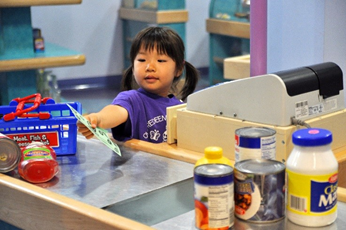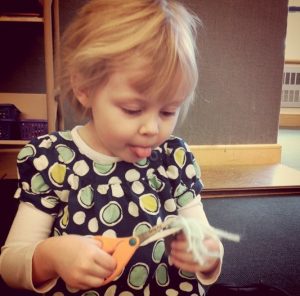1950s: Piaget
Dawn Rymond; Antoinette Ricardo; Jennfier Paris; Lumen Learning; and Diana Lang
Piaget: Cognitive Development Theory
Jean Piaget studied how children and youth gradually become able to think logically and scientifically, resulting in his Cognitive Development Theory. Cognition refers to thinking and memory processes, and cognitive development refers to long-term changes in these processes. He was one of the first to recognize and map out the ways in which children’s thought differs from that of adults. His interest in this area began when he was asked to test the IQ of children and began to notice that there was a pattern in their wrong answers.[1]
Piaget believed that children’s intellectual skills change over time based on biological predispositions and their own individual interactions with the world. He was very critical of teacher-directed instruction, believing that teachers or caregivers who take control of the child’s learning place the child into a passive role.[2] According to Piaget, children of differing ages interpret the world differently; therefore, he divided this learning into four stages. His stages assumed a sequence of thinking patterns with these key features:
- They always happen in the same order.
- No stage is ever skipped.
- Each stage is a significant transformation from the stage before it.
- Each later stage builds upon and incorporates the earlier stages.
Sensorimotor Stage
Piaget described intelligence in infancy as sensorimotor, or based on direct, physical contact via the use of their senses. Infants taste, feel, pound, push, hear, and move in order to experience the world.
Watch this video for an example of a child who has not mastered object permanence.
Preoperational Stage
Piaget’s stage that coincides with early childhood is the preoperational stage. The word operational means logical, so these children were thought to be illogical. However, they learn to use language and to think of the world symbolically.

Pretending is a favorite activity during the preoperational stage. A toy has qualities beyond the way it was designed to function and can now be used to stand for a character or object unlike anything for which it was originally intended. A teddy bear, for example, can be a baby or the queen of a faraway land!
Watch this Preoperational Stage example video. Note that children in the Preoperational Stage exhibit symbolic play, egocentrism, lack of understanding conservation tasks, and inability to understand reversibility.
Egocentrism
Egocentrism in early childhood refers to the tendency of young children to think that everyone sees things in the same way as them. This trait is particularly common in the preoperational stage.
Concrete Operational Stage

This stage takes place from around 7 years old to 11 years of age and is characterized by the development of organized and rational thinking. The child is now mature enough to use logical thought or operations (e.g., rules) but can only apply logic to physical or “concrete” objects and events (hence the name “concrete operational”). Children gain the abilities of conservation (number, area, volume, orientation) and understand that when concrete objects change in appearance, they still contain the same volume, area, number, and orientation and can return to their original state (reversibility).[3]
Their rules of thinking still seem very basic by adult standards and usually operate unconsciously, but they allow children to solve problems more systematically than before, and therefore to be successful with many academic tasks. For example, a child may unconsciously follow the rule: “If nothing is added or taken away, then the amount of something stays the same.” This simple principle helps children to understand certain arithmetic tasks, such as adding or subtracting zero from a number.
Watch this video for an example of a child who has not mastered concrete operations. Note that this child does not understand conservation or reversibility.
For more information, watch this video about Concrete Operations.
Formal Operational Stage
During this stage, adolescents are able to understand abstract principles. They are no longer limited by what can be directly seen or heard and are able to contemplate constructs such as beauty, love, freedom, and morality. Adolescents demonstrate hypothetical-deductive reasoning, which is developing hypotheses based on what might logically occur. They are able to think about all the possibilities in a situation beforehand, and then test them systematically because they are able to engage in scientific thinking.
Watch this informational video about the Formal Operations Stage with a focus on Child Psychology for more information.
| Name of Stage | Description of Stage |
|---|---|
| Sensorimotor Stage | During the sensorimotor stage, children rely on the use of the senses and motor skills. From birth until about 2 years, the infant learns by tasting, smelling, touching, hearing, and moving objects around. This is a hands-on type of knowledge. |
| Preoperational Stage | In the preoperational stage, children from ages 2 to 7 years become able to think about the world using symbols. A symbol is something that stands for something else. The use of language, whether it is in the form of words or gestures, facilitates knowing and communicating about the world. This is the hallmark of preoperational learning and it typically occurs in early childhood. However, these children are preoperational or pre-logical. They still do not understand how the physical world operates. They may, for instance, fear that they will go down the drain if they sit at the front of the bathtub, even though they are too big. |
| Concrete Operational Stage | Children in the concrete operational stage, ages 7 to 11 years, develop the ability to think logically about the physical world. Middle childhood is a time of understanding concepts such as size, distance, and constancy of matter, and cause and effect relationships. A child knows that a scrambled egg is still an egg and that 8 ounces of water are still 8 ounces no matter what shape of glass contains it. |
| Formal Operational Stage | During the formal operational stage children, at about 12 years of age, acquire the ability to think logically about concrete and abstract events. The teenager who has reached this stage is able to consider possibilities and to contemplate ideas about situations that have never been directly encountered. More abstract understanding of religious ideas, morals, or ethics, and abstract principles such as freedom and dignity can be considered. |
Criticisms of Piaget’s Theory
Critics have discovered a considerable variation in what children are able to do at various ages in different parts of the world and in different cultures. Further, many contend that Piaget may have underestimated what children are capable of given the right circumstances.[4] For instance, he believed that learning peaked around the age of 12 years, designated by his last stage—formal operational stage.
- Children develop cognitively through stages—sensorimotor, preoperational, concrete operational, and formal operational.
- Each stage must be mastered before moving on to the next stage.
- Children’s intellectual skills change based on their direct experiences with the environment.
- This chapter is an adaptation of Child Growth and Development by Paris, Ricardo, & Rymond, and Child Development by Lumen Learning, used under a CC BY 4.0 license. ↵
- Crain, W. (2005). Theories of development concepts and applications (5th ed.). Pearson Education, Inc. ↵
- Lally, M., & Vlentine-French, S. (2017). Lifespan development:
A psychological perspective. College of Lake County Foundation. http://dept.clcillinois.edu/psy/LifespanDevelopment.pdf. ↵ - Lumen Learning. (n.d.). Lecture transcript: Developmental theories. https://courses.lumenlearning.com/lifespandevelopment2/chapter/lesson-2-lecture-transcript/. ↵
The development of processes that enhance conscious understanding. Cognitive development can be seen in children with the appearance of remembering, problem solving, and decision-making.
The tendency of young children not to be able to take the perspective of others, and instead the child thinks that everyone sees, thinks, and feels just as they do.

